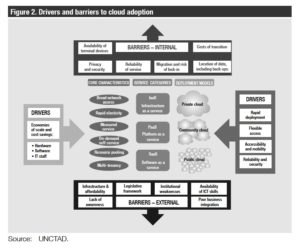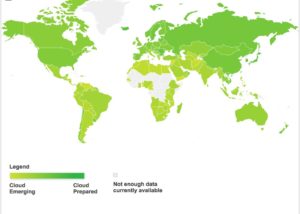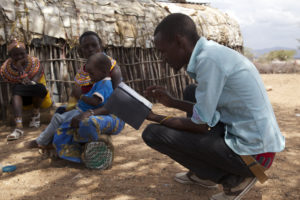
Search
Is using ICT4D cloud computing to collect and analyze field data or manage far flung operations pie in the sky? No, but employing this quickly growing technology in developing countries amidst connectivity constraints, data security concerns and information sovereignty questions is not without challenges.
Once an organization decides to switch from its dog-eared, paper-based field data collection system to mobile devices, the question becomes, “Where will the data be stored and what level of data analysis needs to be done?” Since there are a range of mobile apps that can be used to upload data to databases, what you’re really selecting when considering where and how to store your data is the type of backend storage and computing system that best supports your organization’s work.
You can use a cloud server (also known as a “public cloud”) like Amazon AWS, Microsoft, or Salesforce.com (for which TaroWorks is a mobile data collection and analysis, offline CRM and field force management tool). In all of these cases, the same set of data and computing applications are stored on the cloud provider’s servers and are accessible to multiple users via the internet. Or, you can employ an on-premises solution (also known as a “private cloud”), which stores data and applications locally on an organization’s own servers and makes it accessible to multiple users through internal networks – over which you have more control. There are benefits and tradeoffs to each, not to mention a hybrid cloud option that combines the two, but more on that later.
The idea of using the cloud for development is gaining popularity. In a 2013 assessment of “The Cloud Economy and Developing Countries” United Nations Secretary-General BAN Ki-moon lauded the cloud’s potential for fostering economic and social development and furthering Millennium Development Goals. A 2016 World Economic Forum report said with help from cloud provided services, “… the financial barriers to new business entry have fallen significantly,” providing both startups and small to medium enterprises the ability to scale and remain resilient.
In the less lofty world where social enterprises and NGOs make hard choices about field data collection and analysis (as well as data storage) and need technology platforms to manage sales teams and supply chains, the tradeoffs between cloud, on-premises or hybrid options often turn on:
Here’s how the cloud, on-premises and hybrid cloud stack up when measured against the four factors – cost, connectivity, collaboration and data complexity.

Winner – Cloud: SMEs and nonprofits can reduce upfront and ongoing hardware and software costs by utilizing ICT4D cloud computing as it relies on servers and system architecture owned and managed remotely by Infrastructure as a Service (IaaS) or Platform as a Service (PaaS) cloud providers as well as software applications and mobile apps developed, hosted and regularly enhanced by Software as a Service (SaaS) cloud companies like TaroWorks.
The on-premises computing and data storage approach, on the other hand, requires expertise in server setup and maintenance, security and in some cases application development. Software Advice, a Gartner company, has a calculator, which helps weigh the costs of a cloud system versus an on-premises setup.
Winner – Hybrid Cloud: There’s an obvious hurdle to using ICT4D cloud computing when you’re working outside of cities in developing countries. Your ability to connect to remotely hosted databases from the field or use cloud driven CRMs is only as good as your internet or mobile data connection.
If you need to access data directly from a location where fixed and mobile data infrastructure and bandwidth is spotty, one alternative is building an on-premises data storage system that hosts data in a Network Attached Storage device and connects to users over an internal network. You’re still without internet connectivity, though, which is where hybrid clouds can give multiple users access to both locally stored content and periodic connections to the internet for downloads. Brck’s Kio Kit is an example of this hybrid cloud approach at work in Kenyan schools and it’s recently released SupaBrck is a “solar-powered Wi-Fi box that operates as a 3G hotspot and off-grid server.”
Operating in areas with little or no internet or mobile connectivity is not the death knell for accessing the cloud from a mobile device either. A growing number of mobile apps like TaroWorks or custom built apps using Open Data Kit allow field teams to collect data offline and in some cases, navigate geography or even view video with no connectivity. The newly collected information saved on a smartphone or tablet can be synced back to the cloud when within range of mobile data or internet service.
We’ve focused on mobile data collection and field operations management in the African, Latin American and Asian countries where fixed (Ethernet) and mobile bandwidth are becoming more robust, according to Cisco’s Cloud Readiness Index.

Source: Cisco
Winner – Cloud: You’ve collected the data – now what? Having a web-based destination accessible by multiple, simultaneous users (from different time zones) where data can be visualized, shared and discussed in real-time, is one of the cloud’s strengths.
Using ICT4D cloud computing can bust through data silos – created when program data is housed on local servers in each country where it is collected – by letting anyone in an organization view the same data regardless of their location. It’s also a way to provide access to metrics for customers, beneficiaries, donors or business partners. Connected to a smartphone or tablet, cloud-hosted CRMs are able to push survey results or content back out to the field.
Our customer BOMA Project, which implements a poverty graduation program in rural Northern Kenya, uses mobile devices and cloud-hosted data analysis to close feedback loops between the women entrepreneurs it supports and the experts providing them with advice to launch small businesses and start a savings program in their community. Data on business progress and feedback from each entrepreneur can be uploaded and analyzed quickly allowing BOMA business coaches to adjust the advice they give these women based on data results and trends.

BOMA Project field team member in Northern Kenya. Source: TaroWorks
Winner Scalability – Cloud: As an operation’s data and computing needs grow, cloud systems expand quickly and for less upfront hardware and software cost than on-premises computing. Depending on the amount of data to collect and the complexity of the data management and analysis, the cloud can also apply more computing power to problem solving than you’d be able to on your own.
Our customer iDE employed the ICT4D cloud computing to balance supply and demand in its Cambodia-based latrine manufacturing and sales WASH program. Using mobile data collection and cloud-based CRM tools, iDE tracked goods from factory to installation. It counted on the cloud’s flexibility to quickly meet a need for more field data collectors and data storage as the program ramped up. The iDE team now manages over 6,000 orders for sanitary toilets a month, operating a complex network of 200 sales agents, 100 independent latrine manufacturers and 25 supply chain coordinators.

Source: iDE WASH Program
Winner Data Migration – Cloud: Moving locally stored data and related applications to a cloud server is one of the most daunting tasks when switching from on-premises to cloud. It can even be complicated transferring content between two cloud-hosted databases. Don’t underestimate the challenge and rank the cloud service provider’s data migration capabilities among the more important selection criteria when considering ICT4D cloud computing. The good news is there are subscription services you can purchase to help automate the flow of data between two technologies and data integration consultants who can help make the transfer successful – frequently by using an API.
Winner Data Security – On-Premises: The spate of news reports about database hacking, malware, phishing campaigns and denial-of-service attacks have heightened security concerns about hosting data on servers accessible through the internet – over which the cloud user has no control. That has prompted some organizations, especially those collecting sensitive health and government information, to opt for an on-premises database that can be placed behind a firewall they manage, subject to permissions they control, using infrastructure they’ve configured.
The large cloud service providers take pains to bolster their data and hardware security so check their trust and security web page to see if it gives you a level of comfort. If that’s not enough, there are tools that can help verify and strengthen the integrity of all forms of cloud hosting. A study of SMEs in Nigeria found that these businesses actually value the cloud as a more reliable data storage option than on-premises alternatives when confronted with data storage risks like frequent loss of power.
Winner Data Sovereignty – On-Premises: If you are working with government data, hosting that information on servers outside of the country from which the data originates can be illegal. In Nigeria, for example, there are no comprehensive cloud usage regulations but all government data must be hosted in-country. (Read More) On-premises computing allows you to keep the data in the country of origin as does a local cloud service provider. Check on data sovereignty rules for the countries in which you’ll be collecting information and review the data hosting policy of any potential cloud hosting platform.
Has using ICT4D cloud computing achieved the promise hoped for in the United Nation’s 2013 assessment? No, but it has become a serious option for data collection and analysis as well as managing field operations. The challenge is determining whether what the cloud does well is what your organization needs most.
Editor’s Note: This blog post first appeared on ICTWorks.
POST TOPICS
Sign up to receive emails with TaroWorks news, industry trends and best practices.
TaroWorks, a Grameen Foundation company.
Site by V+V